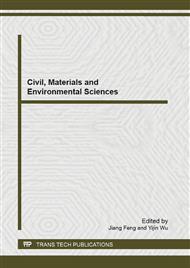p.231
p.237
p.243
p.249
p.257
p.262
p.268
p.272
p.278
The Research of Micro-Flocculation Suspended Sludge Filtration Technology in the Treatment of Oilfield Wastewater
Abstract:
Enhanced Oil Recovery has been used in most oil field of China, but the oil field wastewater was more difficult to treat than that from water flooding. In this paper, FX flocculants (FX-F) prepared in our laboratory was chosen as the optimal flocculants compared with aluminium polychlorid (PAC), polyaluminium ferric chloride (PAFC). The optimal dosage of FX flocculants was 4 mg/L based on the field test, at which the SS content of treated oil field wastewater reduced sharply within 10 hours. The 15 mg/L of the FX-F would be the most convenient to form the sludge layer. Taking FX-F as flocculants, the oil field wastewater was treated in the micro-flocculation suspended sludge filtration process, and the results showed that the SS and Oil of wastewater could be significantly be reduced. In the end, the average oil content was lower than 1 mg/L and the removal rate can reach 99%, and the average content and the removal efficiency of SS was 1.26 mg/L and 95% respectively, which can really meet the standards for oil field rejection water.
Info:
Periodical:
Pages:
257-261
Citation:
Online since:
August 2013
Authors:
Price:
Сopyright:
© 2013 Trans Tech Publications Ltd. All Rights Reserved
Share:
Citation:


